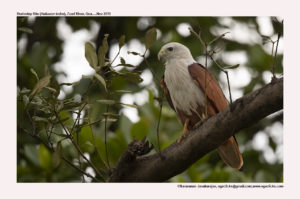
Brahminy Kite Haliastur indicus
Etymology:
- Haliastur : Greek word hali– sea; Latin word astur- hawk
- Indicus: From India
Vernacular Names : Sind: Pilyo, Rutta okab, Hindi: Brahmini cheel, Sankar cheel, Dhobia cheel, Roo mubarak, Khemkarni, Sans: Khemankari, Shemkari chill, Pun: Bahmani ill, Santhali: Kehe, Ben: Shankha cheel, Ass: Ranga cheelani, Guj: Brahmani cheel, Bhagui samali, Mar: Sagaari ghar, Ori: Sankhachila, Ta: Sem parundu, Krishna parundu, Garuda parundu, Te: Garuda lawa, Garutmantadu, Bapana gadda, Yerkali: Shemberid, Mal: Garudan, Krishna parundu, Kan: Garuda, Giduga, Sinh: Ukussa
Distribution in India: Widespread resident in India other than North West and North east.
Description: Size of 44–52 cm; wt. of male 409–650 g, wt. of female 434–700 g; wingspan of 110–125 cm. The adult has chestnut back, wings and belly and white head, neck and breast. The female is similar but larger and heavier. The juvenile is blackish brown with spots and streaks above and brownish with streaks below.
Habitat It is found in coasts, estuaries, rivers, lakes, swamps, marshes, reservoirs, rice fields and urban areas. It is found from sea-level to 3000 m.
Food habits: It eats small animals and carrion, including mammals, birds, reptiles, amphibians, fish, arthropods, crustaceans, shellfish, cuttlefish, road-killed vertebrates, large carcasses and domestic poultry. It forages by quartering and high soaring, or hunting from prominent perch. It seizes prey by glide or dive that may become short chase; hawks flying insects, snatches prey from tree canopy and water surface, and robs other predators. It can consume prey in flight.
Breeding habits: It breeds in dry season in tropics, late winter and spring in subtropics. The nest is a platform of sticks and other flotsam 40–60 cm wide, up to 20 cm deep, lined with leaves and other soft material including human rubbish. They lay a clutch of 1–2 eggs. The incubation period is 26–35 days done by both sexes. The fledging period is 40–45 days. The males provide most food for females and nestlings early in nestling period.